Welcoming a bearded dragon baby into your home is both exciting and rewarding. These tiny reptiles are full of personality, curiosity, and energy—but they also require special care and attention during their early stages of life. Unlike adult beardies, a bearded dragon baby has specific needs when it comes to food, heat, lighting, and habitat setup to ensure proper growth and health.
Whether you’re a first-time reptile owner or expanding your scaly family, understanding how to care for a bearded dragon baby is essential. In this guide, we’ll cover everything you need to know to give your little dragon the best start—so they grow into a happy, healthy adult.
What to Expect When Raising a Young Bearded Dragon Baby
Raising a young dragon comes with unique challenges and rewarding moments. At this early stage, they are still developing physically and behaviorally, which means your care routine plays a crucial role in their growth. Let’s take a closer look at what makes hatchlings different, how they behave, and how quickly they mature.
Understanding the Hatchling Stage of a Bearded Dragon Baby
The hatchling stage is the most delicate phase in the life of a Pogona vitticeps, commonly known as the bearded dragon. At just a few inches long, hatchlings are fragile, fast-moving, and highly sensitive to their environment. During this stage, their immune systems are still developing, making proper hygiene, heat, and nutrition absolutely essential.
Hatchlings typically require more frequent feedings than juveniles or adults—often 3 to 5 times per day—due to their rapid growth. Their diet should consist mainly of small, gut-loaded insects and finely chopped greens. Enclosure temperatures must remain consistent, with a warm basking spot and a cooler retreat to allow for proper thermoregulation.
Because bearded dragon hatchlings are prone to stress, sudden changes in their setup, diet, or handling routines should be avoided. Their small size also makes them more vulnerable to dehydration and impaction, so substrate choice and hydration methods must be carefully considered. Understanding the needs of a hatchling helps lay the foundation for a healthy, thriving adult dragon.
Behavioral Traits of Juvenile Bearded Dragons
Young bearded dragons, or juveniles, often display behaviors that are different from their adult counterparts. They tend to be more skittish, alert, and reactive to new environments. It’s normal for a young beardie to dart quickly, puff up, or wave its arms—these are instinctual behaviors used for communication and self-defense.
Bonding during this stage requires patience and consistency. Start by letting your dragon observe you without direct handling. Gradually introduce short, gentle interactions. Over time, this builds trust and reduces fear-based responses.
Juveniles also explore their surroundings frequently, so make sure the enclosure has safe climbing spots and hiding areas. Frequent glass surfing (pacing against the glass) may indicate boredom or stress. Regular interaction, a stable routine, and a calm environment help your bearded dragon feel secure.
By learning to read their body language and reactions, you can form a strong bond with your young reptile while supporting healthy behavioral development.
Growth Timeline for Bearded Dragon Babies: How Fast Do They Grow?
Bearded dragons grow rapidly during the first year of life. In just a few months, a hatchling measuring 3 to 4 inches can reach over 12 inches in length. This fast growth rate is completely normal and expected when proper care, diet, and lighting are provided.
Most growth timelines break down into three key stages: hatchling (0–3 months), juvenile (3–6 months), and sub-adult (6–12 months). During the hatchling stage, growth can be as much as 1 to 3 inches per month. By six months, many bearded dragons are already close to their adult size.
Using a size chart to track your dragon’s progress helps detect any developmental issues early. Healthy growth is typically steady and noticeable. Sudden changes in appetite, activity, or size may signal a problem.
Weigh your beardie weekly and record the measurements. This makes it easier to spot trends and stay on top of their development. Regular monitoring ensures your bearded dragon grows into a strong, well-proportioned adult.
Bearded Dragon Baby Habitat Setup: Creating a Safe and Comfortable Environment
A well-designed tank environment is key to helping your young dragon feel secure and thrive. From choosing the right enclosure to selecting safe materials, every part of your baby bearded dragon setup matters. In this section, we’ll cover how to create a space that supports healthy growth and natural behaviors.
Choosing the Right Enclosure Size
Choosing the correct enclosure size is an important first step when setting up your baby dragon’s habitat. A 20-gallon starter tank is generally recommended for hatchlings and small juveniles. It provides enough space for movement without overwhelming them.
A tank that’s too large may make it harder for your baby dragon to find food or regulate body temperature. On the other hand, a space that’s too small can restrict natural behaviors like basking, climbing, and exploring. That’s why it’s best to start with a 20-gallon tank and upgrade as your pet grows.
Make sure the enclosure has a secure screen lid and good airflow. It should also allow for a proper heat gradient, with a basking area on one end and a cooler zone on the other. Keep in mind that you’ll likely need a larger tank—such as a 40-gallon breeder or 120-gallon setup—by the time your dragon reaches adulthood.
Starting with the right enclosure size helps promote healthy development and keeps your baby dragon safe and comfortable.
As your dragon grows, consider upgrading to a spacious enclosure like a 120-gallon tank setup.
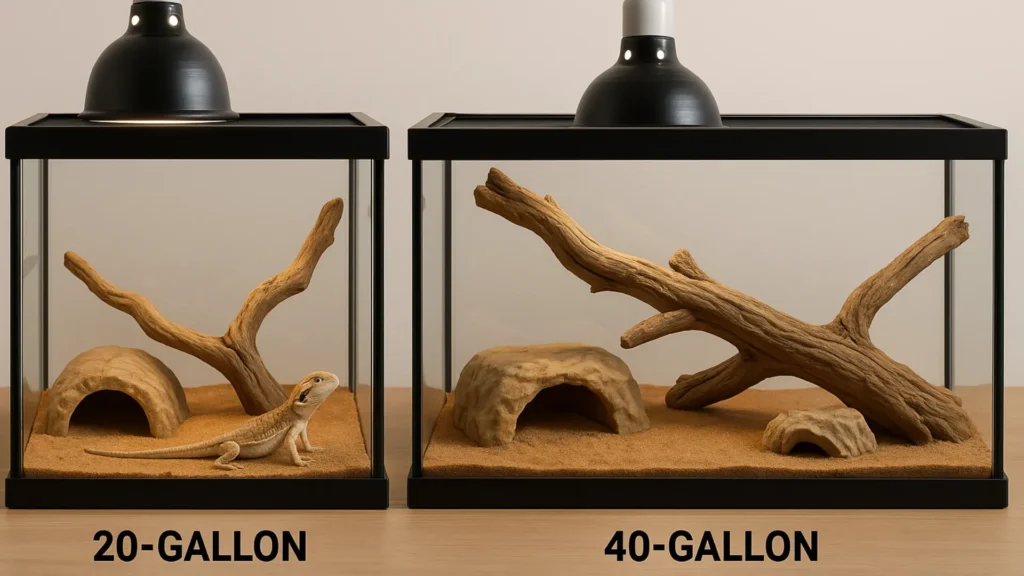
Substrate Safety for Your Bearded Dragon Baby
Keeping your bearded dragon baby safe starts from the ground up—literally. The substrate you choose plays a critical role in their health, especially during the delicate hatchling stage. Loose substrates like sand, crushed walnut, or wood chips can cause impaction if accidentally swallowed—an all-too-common and life-threatening issue in young dragons.
Instead, opt for non-loose, hygienic materials. Two of the best options are:
Paper Towels – Simple, Safe, and Affordable
Paper towels are highly recommended for the early months of your bearded dragon baby’s life. They’re inexpensive, disposable, and make spotting waste effortless. This helps you maintain excellent hygiene—crucial while your hatchling is still building up its immune system.
Reptile Carpet – Reusable and Hatchling-Friendly
Another great choice is reptile carpet, which provides gentle texture and traction for tiny claws. It’s reusable and easy to clean. Just be sure to wash it regularly to prevent bacteria buildup that can cause illness.
Avoid scented, dyed, or chemically treated substrates, as they may irritate your dragon’s skin or respiratory system.
Keeping it clean and simple ensures your little beardie grows up healthy and confident.
How to Decorate a Bearded Dragon Baby Enclosure for Exploration
A stimulating environment is essential for a bearded dragon baby’s physical and mental development. Creating a well-decorated tank doesn’t just make it look nice—it encourages curiosity, activity, and natural behavior.
Add Branches and Climbing Structures
Introduce sturdy, low-profile branches and climbing logs so your hatchling can bask, stretch, and explore. These enrich their experience and help build muscle strength.
Provide Hideouts for Comfort and Safety
Bearded dragon babies feel safer with hideouts available on both warm and cool ends of the enclosure. Small caves, half logs, or even clean cardboard shelters offer great temporary solutions to reduce stress and promote rest.
Keep Visual Variety Without Overcrowding
Add safe décor like faux plants or background scenes, but avoid clutter. Too many items can overwhelm a young dragon or restrict movement. Prioritize a layout that feels natural but easy to navigate.
Decorating thoughtfully supports exploration while giving your beardie a sense of home and security.
Monitoring Humidity and Ventilation for Bearded Dragon Babies
Humidity and airflow are often overlooked but are absolutely vital for a bearded dragon baby’s health. These desert reptiles need a controlled environment to avoid illness and stress.
Ideal Humidity Range for Hatchlings
Maintain humidity between 30%–40% to prevent respiratory problems and shedding issues. Use a digital hygrometer placed inside the tank (not on the lid) to monitor levels accurately.
Ensure Consistent, Clean Ventilation
Fresh air is just as important as heat and humidity. A secure screen top allows for natural air exchange and keeps the tank from becoming stale or too moist.
Avoid covering the enclosure with damp towels or plastic, as this traps moisture and encourages bacterial growth.
A well-ventilated, properly humidified enclosure helps your baby bearded dragon thrive from day one.
Lighting and Heat Requirements for Proper Development
To grow strong and stay healthy, young dragons need the right environmental conditions. Proper warmth and exposure to specific types of light support digestion, bone strength, and energy levels. In this section, we’ll explore how to set up these essential elements for your baby bearded dragon’s enclosure.
Why UVB Is Essential for Bone Health
UVB lighting plays a critical role in your baby bearded dragon’s bone development. Without enough UVB exposure, they cannot properly absorb calcium from their diet. This can lead to metabolic bone disease, a serious and often irreversible condition that causes deformities, weakness, and even death.
To prevent this, you’ll need a reliable UVB bulb in the enclosure. A popular choice among reptile owners is the Reptisun 10.0. This bulb provides the necessary UVB rays to support healthy calcium metabolism. Make sure the light covers at least two-thirds of the tank and is placed at the proper distance—usually 10 to 12 inches above the basking area.
Replace the bulb every 6 to 12 months, even if it still lights up. UVB output fades over time, even when the bulb looks fine. Without consistent exposure to UVB, your young dragon’s growth will suffer.
Regular UVB lighting, combined with a calcium-rich diet, helps ensure your baby dragon grows strong, active, and free of bone-related issues.
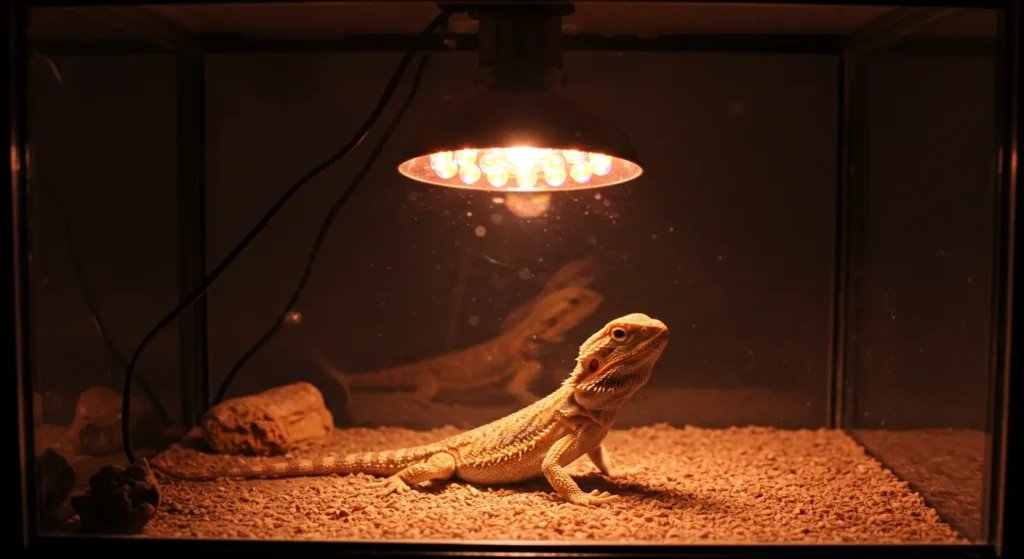
Setting Up the Ideal Basking Spot
A proper basking spot is essential for your baby dragon’s digestion and daily activity. Bearded dragons are cold-blooded and rely on external heat to regulate their body temperature. The basking area should be the warmest part of the tank and easy for your dragon to access.
For hatchlings and juveniles, the basking temperature should be between 100°F and 110°F. This allows them to absorb enough heat for healthy growth. Place a heat bulb directly above a flat surface like a rock or branch where your dragon can rest comfortably.
Use a digital thermometer with a probe to check the temperature right at the basking surface—not just the air above it. This ensures accuracy and helps avoid overheating. Avoid placing the basking spot too close to the heat source, as it could cause burns.
Position the basking area on one side of the tank. This creates a natural heat gradient, with a cooler zone on the opposite side. A well-set basking spot supports your dragon’s energy, appetite, and overall well-being.
Managing Nighttime Temperature Drops
At night, temperatures naturally drop—but your baby dragon still needs a warm and stable environment. While adult bearded dragons can handle cooler nights, hatchlings are more sensitive. If the room temperature falls below 65°F (18°C), you’ll need to provide extra warmth to keep your pet safe and healthy.
A ceramic heat emitter (CHE) is the best option for nighttime heating. Unlike regular bulbs, it produces heat without emitting light, so it won’t disturb your dragon’s sleep cycle. Place it above the cooler end of the tank to gently warm the space without overheating the basking area.
Use a reptile thermostat to regulate the temperature and prevent overheating. It allows you to set a minimum temperature, turning the heater on and off automatically. Always monitor nighttime temps with a reliable digital thermometer.
Keeping nighttime temperatures within a safe range helps your young dragon rest comfortably and maintain proper digestion and immune function.
Feeding Guidelines for a Growing Reptile
Nutrition plays a vital role in your young dragon’s growth and overall health. Providing the right foods in the right amounts helps support energy levels, digestion, and development. In this section, we’ll explore what to offer, how often to serve it, and which supplements can make all the difference.
Daily Insect Feedings: What and How Often
bearded dragon babys need a high-protein diet to fuel their rapid growth. Insects should make up the bulk of their meals during the first few months. Offer small, easy-to-digest feeders like dubia roaches, crickets, and phoenix worms.
Feed your baby dragon 3 to 5 times a day. Each feeding should last about 10 to 15 minutes. Only offer insects smaller than the space between your dragon’s eyes to prevent choking.
Rotate feeders to provide variety and avoid over-reliance on one insect type. Always use gut-loaded insects—those fed nutritious foods—before offering them to your dragon. This improves their nutritional value.
Remove any uneaten insects after feeding to prevent them from biting or stressing your pet. A consistent insect routine helps your dragon stay active, alert, and properly nourished.
Introducing Safe Greens and Vegetables
While insects are the main focus, greens should also be introduced early. Offering small amounts of leafy vegetables teaches your baby dragon to accept plant-based foods as it grows.
Good options include collard greens, mustard greens, and dandelion leaves. These are rich in calcium and fiber but low in oxalates, making them safe for reptiles.
Chop the greens into fine pieces and mix them with insects during feeding times. This encourages your dragon to nibble on plants. Avoid spinach, iceberg lettuce, and kale, as they offer little value or can interfere with calcium absorption.
Offer fresh greens daily, even if your dragon doesn’t eat much at first. Over time, their interest in vegetables will grow. Early exposure sets the stage for a balanced adult diet.
When offering greens, always check for safety—like spinach, which may not always be ideal.
Calcium and Vitamin Supplement Schedules
Supplements are essential for preventing health issues in young dragons. Use calcium powder with D3 to support strong bones and proper growth. Without it, your dragon may develop metabolic bone disease.
Dust feeder insects with calcium 4 to 5 times per week. For added balance, include a reptile multivitamin once or twice a week. Choose a product made specifically for reptiles to ensure proper ratios.
Avoid overdosing. Too much vitamin D3 or A can be harmful. Stick to a consistent schedule and rotate calcium and multivitamins to avoid imbalances.
Supplements work best when combined with UVB lighting. Together, they help your dragon absorb nutrients effectively. A well-supplemented diet supports a long, healthy life.
Signs of Healthy Eating Behavior
A healthy appetite is a great sign your baby dragon is thriving. Eager feeding, active hunting, and quick response to movement all indicate good health.
Monitor poop consistency regularly. Healthy stool should be firm and dark, with a small white urate at the end. Runny, smelly, or discolored waste may signal diet issues or illness.
Pay attention to energy levels. A well-fed dragon will be alert, responsive, and curious about its surroundings. If your dragon becomes lethargic, stops eating, or hides excessively, something may be wrong.
Regular observation helps you catch problems early. Healthy eating behavior shows that your setup, lighting, and diet are all working well.
Tracking Health and Spotting Early Issues
Keeping a close eye on your young dragon’s health is essential during its early months. Subtle changes in behavior, appearance, or appetite can signal potential problems. In this section, we’ll cover how to monitor growth and recognize early warning signs before they become serious.
How to Monitor Growth and Weight
Tracking your baby dragon’s growth helps you catch potential issues early. Use a small reptile scale to weigh your dragon once a week. Record the weight in a log or chart so you can track changes over time.
In addition to weight, measure your dragon’s length from nose to tail tip. Healthy hatchlings grow quickly, especially during the first six months. A steady increase in both size and weight usually means your dragon is thriving.
Sudden drops in weight or stalled growth can signal poor nutrition, stress, or illness. Weekly check-ins also help you notice changes in appetite or activity. Regular monitoring gives you confidence that your care routine is working.
Signs of Stress or Illness to Watch For
Recognizing early signs of stress or illness can prevent more serious problems. One common indicator is stress marks—dark lines or spots on the belly or chin. These often appear when your dragon feels unsafe or uncomfortable.
Other red flags include glass surfing, where your dragon repeatedly scratches or runs along the tank walls. This can signal boredom, fear, or poor tank conditions. Also watch for lethargy, lack of appetite, or hiding for long periods.
Healthy dragons are alert, curious, and responsive. If your pet suddenly becomes inactive or stops eating, it’s time to investigate. Minor changes can reveal early health concerns, so it’s important to act quickly.
When to Visit a Reptile Vet
Some issues require more than just home care. If your dragon shows emergency signs like severe weight loss, swollen limbs, or sunken eyes, contact an exotic animal vet right away. Delaying treatment can lead to complications or death.
Also seek help if your dragon hasn’t eaten for several days, struggles to walk, or shows signs of labored breathing. A qualified reptile vet can check for infections, parasites, or other hidden problems.
Routine checkups are also a good idea, especially during the first year. Even if your dragon looks fine, a professional can confirm that growth and development are on track. Early intervention is key to a long, healthy life.
Frequently Asked Questions
How often should I feed my baby bearded dragon?
You should feed a baby bearded dragon 3 to 5 times per day, offering small, gut-loaded insects like dubia roaches and crickets. Each session should last 10–15 minutes. As they grow, the feeding frequency gradually decreases.
What is the best enclosure size for a baby bearded dragon?
A 20-gallon tank is ideal for hatchlings and small juveniles. It offers enough space for exploration without making it hard for them to find food or heat sources. Upgrade to a larger tank (40–120 gallons) as your dragon grows.
How much does a baby bearded dragon cost?
The price of a baby bearded dragon typically ranges from $30 to $100, depending on the morph, breeder, and location. Rare color morphs or dragons from premium bloodlines may cost more. Additional setup costs for habitat, lighting, and food can bring the total to over $200 for first-time owners.
Do baby bearded dragons need water every day?
Yes, baby bearded dragons need access to water daily. While they often get moisture from food, it’s important to mist them lightly or provide a shallow water dish. Some babies may prefer drinking droplets from tank surfaces or leaves, so misting helps encourage hydration.
Do baby bearded dragons need UVB lighting?
Yes. Baby bearded dragons require UVB light daily to absorb calcium and prevent metabolic bone disease. A high-quality bulb like the Reptisun 10.0 should be used and replaced every 6 to 12 months.
What temperature should the basking spot be?
The basking spot should be kept between 100°F and 110°F for hatchlings. Use a digital thermometer to measure temperature directly at the basking surface to ensure safety and effectiveness.
Can I use sand or loose substrate for a baby bearded dragon?
No. Loose substrates like sand, crushed walnut, or wood chips can cause impaction if swallowed. Use safe options such as reptile carpet or paper towels until your dragon is older.
How fast does a baby bearded dragon grow?
Bearded dragons grow quickly during their first year. A hatchling measuring 3–4 inches can grow to over 12 inches by 6 months old. Regular weight checks and measurements help track their progress.
What are signs that my bearded dragon baby is stressed or sick?
Common signs include stress marks, lethargy, glass surfing, loss of appetite, or hiding for long periods. If you notice any of these symptoms, review your setup or consult a reptile vet.
When should I take my bearded dragon baby to the vet?
Visit a reptile vet if your dragon has swollen limbs, labored breathing, isn’t eating for several days, or shows rapid weight loss. Routine checkups are also recommended during their first year.
Conclusion
Caring for a bearded dragon baby may seem overwhelming at first, but with the right setup, routine, and knowledge, it quickly becomes a rewarding experience. From creating a safe habitat to providing the right food, lighting, and daily care, every step you take helps your baby beardie grow into a strong, healthy adult.
By understanding their needs during the early stages of life, you’ll not only ensure proper growth but also build a lasting bond with your reptile companion. Whether you’re a new reptile parent or adding another dragon to your family, following this guide will give your bearded dragon baby the perfect start.

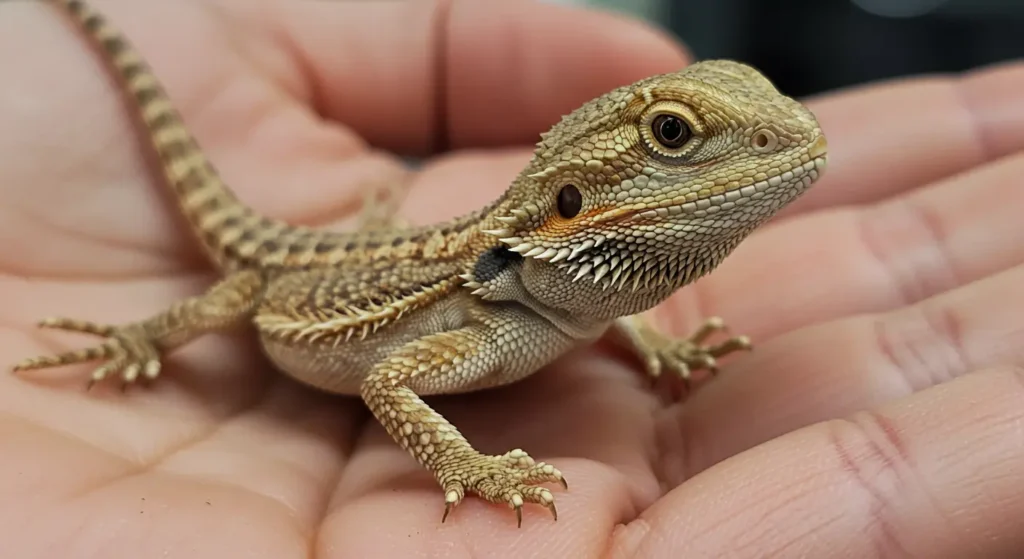
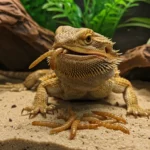

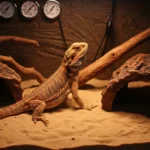
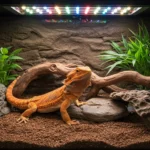
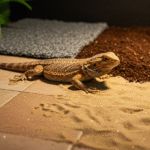
4 thoughts on “Bearded Dragon Baby Care: The Ultimate Starter Guide”